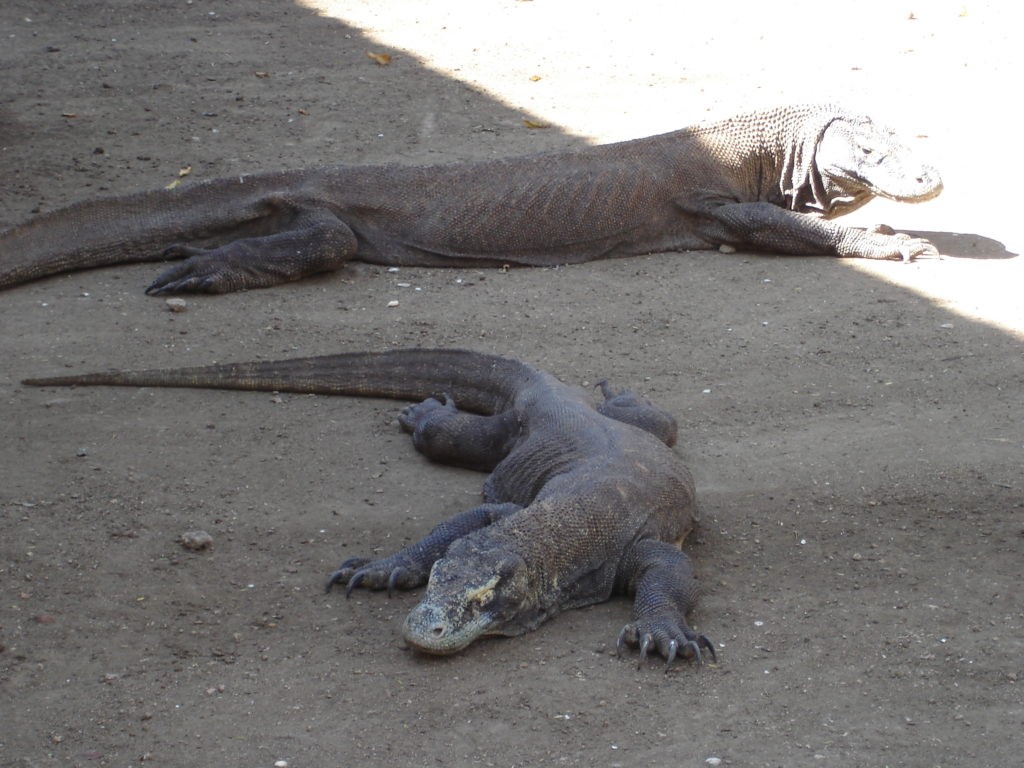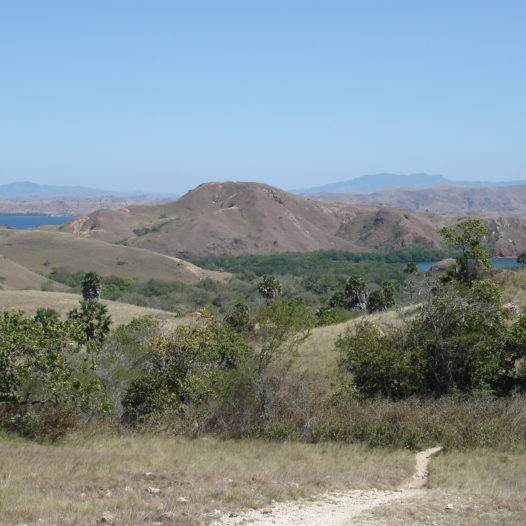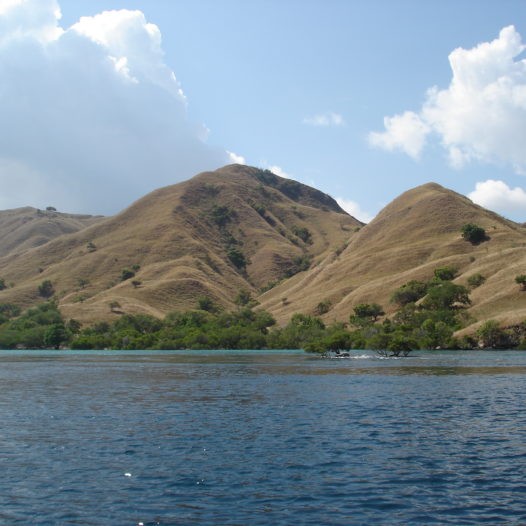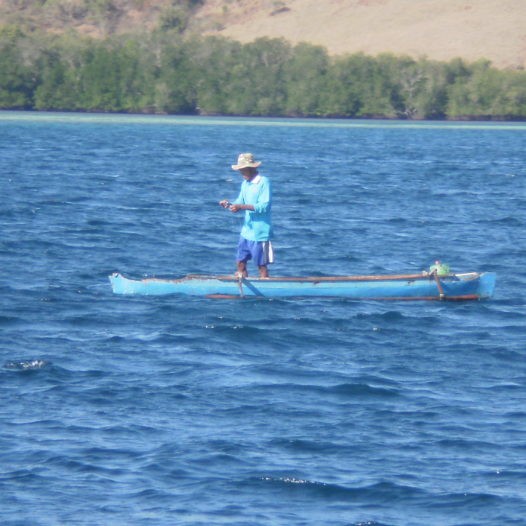Why Are Komodo Dragons Such Assholes? This question delves into the fascinating and sometimes frightening behavior of these apex predators, prompting us to explore their unique characteristics and ecological role. WHY.EDU.VN offers in-depth explanations of animal behavior, including the Komodo dragon, providing insights and dispelling common misconceptions using a wealth of knowledge and expertise. Understanding their behavior, aggression, and venom, along with their predatory instincts, can help clarify why these giant lizards have earned their intimidating reputation.
1. Komodo Dragons: Understanding Their Predatory Behavior
Komodo dragons, the world’s largest lizards, inhabit several Indonesian islands, including Komodo, Rinca, Flores, and Gili Motang. These reptiles are apex predators, meaning they sit at the top of their food chain. Their predatory behavior is multifaceted, influenced by their physical attributes, hunting strategies, and ecological needs. Understanding these elements provides context for the perception of them being aggressive or “assholes.”
1.1 Physical Attributes
Komodo dragons possess several physical traits that contribute to their predatory prowess:
- Size and Strength: Adult Komodo dragons can grow up to 10 feet long and weigh over 300 pounds. Their sheer size and muscular build make them formidable hunters.
- Powerful Limbs and Claws: They have strong limbs and sharp claws used for gripping prey and climbing.
- Strong Jaws and Serrated Teeth: Their jaws are incredibly powerful, and their teeth are serrated, allowing them to tear flesh efficiently.
- Venomous Bite: Komodo dragons have venom glands in their lower jaw that secrete a complex mix of toxins. This venom inhibits blood clotting, lowers blood pressure, and induces shock, weakening the prey quickly.
- Exceptional Sense of Smell: They have an acute sense of smell, enabling them to detect carrion or potential prey from up to several miles away.
1.2 Hunting Strategies
Komodo dragons employ a combination of ambush predation and scavenging. Their hunting strategies are adapted to their environment and the types of prey available:
- Ambush Predation: Young dragons often hunt from concealed locations, ambushing smaller animals like rodents, birds, and insects.
- Stalking and Pursuit: Adult dragons are capable of hunting larger prey, such as deer, pigs, and water buffalo. They often stalk their prey, using their size and strength to bring them down.
- Venom Application: A bite from a Komodo dragon delivers a potent venom that weakens the prey. The dragon may then follow the prey for days, waiting for the venom to take full effect.
- Scavenging: Komodo dragons are opportunistic scavengers. They can detect carrion from great distances and will readily feed on dead animals, reducing competition for resources.
1.3 Ecological Role
The ecological role of Komodo dragons is essential to their ecosystems:
- Apex Predator: As apex predators, they control the populations of their prey species, preventing overgrazing and maintaining ecological balance.
- Carrion Removal: Their scavenging behavior helps remove carrion, preventing the spread of disease and recycling nutrients back into the environment.
- Habitat Maintenance: By preying on various animals, they contribute to the overall health and diversity of their habitats.
1.4 Case Studies and Examples
Several documented instances illustrate Komodo dragon behavior:
- Attacks on Humans: While rare, Komodo dragons have been known to attack humans, particularly when feeling threatened or defending their territory.
- Hunting Ungulates: They have been observed hunting large ungulates such as deer and water buffalo, using their venom to weaken and eventually kill their prey.
- Cannibalism: Young Komodo dragons often face the threat of cannibalism from older individuals. To avoid this, they may spend their early years in trees, feeding on insects and small animals.
1.5 Expert Opinions
According to Dr. Walter Auffenberg, a renowned herpetologist who studied Komodo dragons extensively, their behavior is primarily driven by their need to survive and reproduce. Their aggression is a natural response to competition for resources and threats to their safety.
2. Aggression in Komodo Dragons: Understanding Their Temperament
The perception of Komodo dragons as aggressive stems from several observed behaviors and interactions, particularly concerning territoriality, feeding habits, and defense mechanisms.
2.1 Territoriality
Komodo dragons are territorial animals, especially adult males. They establish and defend territories to secure access to food and mating opportunities:
- Territory Marking: They use scent markings, including feces and secretions from femoral pores, to delineate their territories.
- Aggressive Displays: Male dragons engage in aggressive displays to assert dominance. These displays can include posturing, hissing, and tail lashing.
- Physical Combat: Fights between males can be intense, involving biting, clawing, and grappling. These fights often result in injuries and can sometimes be fatal.
2.2 Feeding Habits
Their feeding habits significantly contribute to their perceived aggression:
- Voracious Appetites: Komodo dragons have voracious appetites and can consume up to 80% of their body weight in a single feeding.
- Competition for Food: When multiple dragons converge on a carcass, intense competition ensues. They may engage in aggressive displays and fights to secure their share of the meal.
- Opportunistic Feeding: They are opportunistic feeders, readily consuming carrion and actively hunting live prey. This behavior often involves aggressive pursuit and capture tactics.
2.3 Defense Mechanisms
Komodo dragons exhibit several defense mechanisms to protect themselves from threats:
- Defensive Posturing: When threatened, they may stand tall, puff up their throats, and hiss loudly to deter potential predators.
- Tail Lashing: They use their powerful tails as weapons, lashing out at perceived threats. A tail strike from a Komodo dragon can be forceful enough to knock down a human or inflict serious injury.
- Biting: If threatened or attacked, they will bite defensively. Their venomous bite can cause severe pain, inhibit blood clotting, and lead to systemic complications.
2.4 Factors Influencing Aggression
Several factors can influence the level of aggression displayed by Komodo dragons:
- Age and Size: Adult males tend to be more aggressive than females and juveniles due to their need to defend territories and compete for mates.
- Hormonal Influences: Testosterone levels in males can influence their aggression, particularly during the breeding season.
- Environmental Conditions: Scarcity of food and water can increase competition and aggression among dragons.
- Human Interaction: Human activities, such as habitat destruction and disturbance, can increase stress levels and lead to heightened aggression in Komodo dragons.
2.5 Examples of Aggressive Encounters
- Territorial Disputes: Documented cases of male dragons engaging in fierce battles over territory, resulting in severe injuries.
- Feeding Frenzies: Observations of multiple dragons fighting over carcasses, exhibiting aggressive behavior such as biting and pushing.
- Defensive Attacks: Instances of dragons attacking humans who approached too closely or threatened them.
2.6 Safety Measures
Safety measures are crucial when interacting with Komodo dragons in their natural habitat:
- Guided Tours: Always visit Komodo dragon habitats with experienced guides who understand their behavior and can ensure visitor safety.
- Maintaining Distance: Keep a safe distance from the dragons, typically at least 15-20 feet, to avoid provoking them.
- Avoiding Provocation: Do not attempt to feed or interact with the dragons, as this can alter their behavior and increase the risk of aggression.
- Protective Gear: Wear appropriate clothing and footwear to protect against bites and scratches.
2.7 Expert Insights
Dr. Claudio Ciofi, a biologist specializing in Komodo dragon behavior, suggests that understanding the context of their actions is essential. Aggression is often a response to specific stimuli, such as competition for resources or perceived threats, rather than an inherent trait.
3. The Venomous Bite: A Key Factor in Their Behavior
The venomous bite of the Komodo dragon is a critical aspect of their predatory behavior and plays a significant role in how they hunt and interact with their environment.
3.1 Discovery of Venom
For many years, it was believed that the Komodo dragon’s bite was lethal due to septicemia caused by bacteria in their saliva. However, recent research has revealed that Komodo dragons possess venom glands that produce a complex mix of toxins.
- Early Theories: Initial assumptions pointed to bacterial infections as the primary cause of death in prey animals bitten by Komodo dragons.
- Venom Glands Identified: In 2009, Dr. Bryan Fry and his team discovered venom glands in the lower jaws of Komodo dragons, confirming that venom plays a significant role in their predatory strategy.
3.2 Composition of Venom
The venom of Komodo dragons is a complex cocktail of toxins designed to incapacitate prey:
- Anticoagulants: These toxins inhibit blood clotting, causing the prey to bleed excessively.
- Hypotensive Agents: These lower blood pressure, inducing shock and weakening the prey.
- Other Toxins: Additional compounds may contribute to muscle paralysis and further physiological disruption.
3.3 How Venom Affects Prey
The venom’s effects on prey are multifaceted and contribute to the dragon’s hunting success:
- Rapid Weakening: The venom rapidly weakens the prey, making it easier for the dragon to pursue and capture.
- Blood Loss: Anticoagulants cause the prey to bleed profusely, leading to further weakening and eventual death.
- Shock and Paralysis: Hypotensive agents and other toxins induce shock and paralysis, immobilizing the prey.
3.4 Hunting Strategy with Venom
The venomous bite has significantly influenced the Komodo dragon’s hunting strategy:
- Bite and Release: They often bite their prey and then release it, allowing the venom to take effect.
- Tracking Prey: They can track their prey for miles, using their acute sense of smell to locate the weakened animal.
- Consuming Prey: Once the prey is sufficiently weakened or dead, they consume it rapidly, often devouring large portions in a single feeding.
3.5 Evolutionary Advantages
The evolution of venom in Komodo dragons provides several advantages:
- Efficient Predation: Venom allows them to take down larger prey more efficiently than they could through physical strength alone.
- Reduced Risk of Injury: By weakening prey quickly, venom reduces the risk of injury to the dragon during the hunt.
- Competitive Advantage: Venom gives them a competitive edge over other predators in their environment.
3.6 Research and Studies
Several studies have explored the venom of Komodo dragons:
- Dr. Bryan Fry’s Research: Dr. Fry’s work has been instrumental in understanding the composition and effects of Komodo dragon venom.
- Toxin Identification: Researchers have identified various toxins in the venom, including kallikrein-like serine proteases and other compounds that disrupt physiological processes.
- Comparative Studies: Studies comparing the venom of Komodo dragons with that of other venomous reptiles have provided insights into the evolution and function of venom systems.
3.7 Medical Implications
Understanding Komodo dragon venom has potential medical implications:
- Anticoagulant Research: The anticoagulants in the venom could inspire the development of new medications for treating blood clotting disorders.
- Drug Discovery: The unique toxins in the venom could serve as templates for designing new drugs with specific pharmacological effects.
3.8 Safety and Precautions
Given the potency of their venom, safety precautions are essential:
- Avoiding Bites: Avoid contact with Komodo dragons to prevent bites.
- First Aid: In the event of a bite, seek immediate medical attention.
- Antivenom Research: Research into developing an antivenom for Komodo dragon bites is ongoing.
3.9 Expert Commentary
Dr. Kenneth Kardong, a comparative vertebrate anatomist, emphasizes that the discovery of venom in Komodo dragons has changed our understanding of their predatory capabilities and ecological role. The venom is a critical adaptation that allows them to thrive in their challenging environment.
4. Komodo Dragons and Humans: Interactions and Conflicts
The interactions between Komodo dragons and humans are complex, involving both coexistence and conflict. Understanding these dynamics is essential for conservation efforts and ensuring human safety.
4.1 Habitat Overlap
Komodo dragons and humans often share the same habitats, leading to increased interactions:
- Human Settlements: Some human settlements are located near or within Komodo dragon habitats.
- Agricultural Areas: Agricultural activities can encroach on dragon territories, leading to conflicts.
- Tourism: The growth of tourism in Komodo National Park brings more people into close proximity with the dragons.
4.2 Risk of Attacks
While attacks on humans are rare, they can occur under certain circumstances:
- Defensive Attacks: Dragons may attack if they feel threatened or cornered.
- Mistaken Identity: In some cases, dragons may mistake humans for prey animals, particularly in areas where they hunt livestock.
- Attraction to Scents: They are attracted to the scent of blood and may approach humans with open wounds.
4.3 Documented Incidents
Several documented incidents illustrate the potential for conflict between Komodo dragons and humans:
- Fatal Attacks: There have been rare cases of fatal attacks on humans, particularly children.
- Non-Fatal Bites: Numerous instances of non-fatal bites have been reported, often resulting in severe injuries and requiring medical treatment.
- Livestock Predation: They frequently prey on livestock, causing economic losses for local communities.
4.4 Mitigation Strategies
Various strategies are employed to mitigate conflicts between Komodo dragons and humans:
- Relocation Programs: Moving dragons away from human settlements to reduce the risk of encounters.
- Community Education: Educating local communities about dragon behavior and safety precautions.
- Habitat Protection: Preserving and restoring dragon habitats to reduce the need for them to venture into human-dominated areas.
- Tourism Management: Implementing responsible tourism practices to minimize disturbance to dragons and ensure visitor safety.
4.5 Conservation Efforts
Conservation efforts are crucial for protecting Komodo dragons and their habitats:
- Protected Areas: Establishing and maintaining protected areas, such as Komodo National Park, to safeguard dragon populations.
- Population Monitoring: Regularly monitoring dragon populations to assess their health and identify potential threats.
- Anti-Poaching Measures: Implementing measures to prevent poaching and illegal trade of dragons.
- Research and Monitoring: Continuous research and monitoring to understand dragon behavior, ecology, and conservation needs.
4.6 Ecotourism Benefits
Ecotourism can provide economic benefits to local communities while promoting conservation:
- Revenue Generation: Tourism generates revenue that can be used to support conservation efforts.
- Employment Opportunities: Ecotourism creates employment opportunities for local people, providing an alternative to activities that may harm dragons.
- Awareness Raising: Tourism raises awareness among visitors about the importance of conserving Komodo dragons and their habitats.
4.7 Safety Guidelines for Visitors
Visitors to Komodo dragon habitats should follow specific safety guidelines:
- Hire a Guide: Always hire an experienced guide who knows how to navigate dragon habitats safely.
- Maintain Distance: Keep a safe distance from the dragons, typically at least 15-20 feet.
- Avoid Provocation: Do not attempt to feed or interact with the dragons.
- Wear Protective Clothing: Wear long pants and sturdy shoes to protect against bites and scratches.
- Heed Warnings: Pay attention to all warnings and instructions from park rangers and guides.
4.8 Community Involvement
Engaging local communities in conservation efforts is essential for long-term success:
- Community-Based Conservation: Involving local people in the management and protection of dragon habitats.
- Incentive Programs: Providing incentives for communities to protect dragons and their habitats.
- Education Programs: Educating local children and adults about the importance of conservation.
4.9 Expert Recommendations
Dr. Tim Jessop, a conservation biologist specializing in Komodo dragons, recommends a holistic approach to conservation that integrates scientific research, community involvement, and sustainable tourism practices. This approach is essential for ensuring the long-term survival of Komodo dragons and the well-being of the communities that share their habitats.
5. Dispelling Myths About Komodo Dragons
Many myths and misconceptions surround Komodo dragons, often exaggerating their danger and aggression. Separating fact from fiction is essential for promoting accurate understanding and effective conservation.
5.1 Myth: Komodo Dragons Are Always Aggressive
Fact: While they can be aggressive under certain circumstances, Komodo dragons are not constantly aggressive. Their behavior depends on factors such as age, sex, territory, and environmental conditions.
5.2 Myth: Komodo Dragon Saliva Is Septic
Fact: The belief that Komodo dragon saliva is septic and causes death through bacterial infection has been debunked. Recent research has confirmed the presence of venom glands that produce a complex mix of toxins.
5.3 Myth: Komodo Dragons Actively Hunt Humans
Fact: Komodo dragons rarely hunt humans actively. Attacks on humans are infrequent and typically occur when dragons feel threatened or mistake humans for prey.
5.4 Myth: Komodo Dragons Are Invincible
Fact: While they are apex predators, Komodo dragons are not invincible. They are vulnerable to habitat loss, poaching, and other threats.
5.5 Myth: All Komodo Dragons Are the Same
Fact: Individual Komodo dragons exhibit variations in behavior, size, and appearance. These differences reflect genetic diversity and adaptation to local conditions.
5.6 Myth: Komodo Dragons Are Unintelligent
Fact: Komodo dragons are more intelligent than commonly believed. They exhibit complex problem-solving skills and can learn to associate humans with food, as demonstrated in captive settings.
5.7 Comparative Table of Myths and Facts
| Myth | Fact |
|---|---|
| Always Aggressive | Aggression depends on factors like age, sex, territory, and environment. |
| Saliva is Septic | Possess venom glands with complex toxins. |
| Actively Hunt Humans | Attacks on humans are rare and typically defensive. |
| Invincible | Vulnerable to habitat loss and poaching. |
| All the Same | Exhibit variations in behavior, size, and appearance. |
| Unintelligent | Exhibit complex problem-solving skills. |




5.8 Why Myths Persist
Several factors contribute to the persistence of myths about Komodo dragons:
- Sensationalism: Media coverage often sensationalizes dragon behavior, exaggerating the danger and aggression.
- Lack of Accurate Information: Many people lack access to accurate information about dragon behavior and ecology.
- Cultural Beliefs: Local cultural beliefs and folklore can perpetuate myths about dragons.
5.9 Promoting Accurate Information
Promoting accurate information about Komodo dragons is essential for fostering understanding and support for conservation:
- Education Programs: Developing and implementing education programs for local communities and tourists.
- Public Awareness Campaigns: Launching public awareness campaigns to dispel myths and promote accurate information.
- Scientific Research: Supporting scientific research to better understand dragon behavior and ecology.
5.10 Expert Advice
Dr. Eleanor Jane Milner-Gulland, a conservation scientist, stresses the importance of evidence-based conservation. Accurate information is essential for developing effective conservation strategies and engaging stakeholders in the protection of Komodo dragons.
6. Evolutionary History of Komodo Dragons
Understanding the evolutionary history of Komodo dragons provides insights into their unique characteristics and behavior. Their evolutionary journey is marked by adaptation, dispersal, and survival in challenging environments.
6.1 Origins
Komodo dragons belong to the monitor lizard family (Varanidae), which has a long evolutionary history dating back to the Cretaceous period.
- Early Monitor Lizards: The earliest monitor lizards evolved in Asia around 65 million years ago.
- Dispersal to Australia: During the Miocene epoch (around 15 million years ago), monitor lizards dispersed from Asia to Australia.
6.2 Australian Ancestry
The ancestors of Komodo dragons likely originated in Australia before migrating to the Indonesian archipelago.
- Fossil Evidence: Fossil evidence suggests that large monitor lizards similar to Komodo dragons inhabited Australia during the Pleistocene epoch.
- Migration to Indonesia: It is believed that these lizards migrated from Australia to Indonesia via land bridges or by swimming between islands.
6.3 Island Adaptation
Once in Indonesia, the ancestors of Komodo dragons adapted to the island environment, evolving into the species we know today.
- Gigantism: Island gigantism, the tendency for island species to evolve larger sizes, played a role in the evolution of Komodo dragons.
- Predatory Role: As apex predators on the islands, they filled a unique ecological niche.
6.4 Genetic Studies
Genetic studies have provided insights into the evolutionary relationships between Komodo dragons and other monitor lizards.
- Phylogenetic Analysis: Phylogenetic analyses have confirmed that Komodo dragons are closely related to other monitor lizards in the Varanus genus.
- Genetic Divergence: Genetic studies have also revealed the degree of genetic divergence between Komodo dragons and their closest relatives.
6.5 Fossil Discoveries
Fossil discoveries have shed light on the evolutionary history of Komodo dragons.
- Pleistocene Fossils: Fossils from the Pleistocene epoch have been found on several Indonesian islands, providing evidence of their presence in the region for thousands of years.
- Ancient DNA: Analysis of ancient DNA from fossil specimens can provide additional insights into their evolutionary history.
6.6 Evolutionary Pressures
Several evolutionary pressures have shaped the evolution of Komodo dragons:
- Predation: The need to capture prey effectively has driven the evolution of their hunting strategies and venom system.
- Competition: Competition with other predators has influenced their territorial behavior and aggression.
- Environmental Conditions: Adaptation to the tropical island environment has shaped their physiology and behavior.
6.7 Timeline of Evolution
| Time Period | Event |
|---|---|
| Cretaceous Period | Early monitor lizards evolve in Asia. |
| Miocene Epoch | Monitor lizards disperse from Asia to Australia. |
| Pleistocene Epoch | Ancestors of Komodo dragons inhabit Australia. |
| Pleistocene Epoch | Lizards migrate from Australia to Indonesia and adapt to the island environment. |
| Present | Komodo dragons evolve into the species we know today, filling the role of apex predator on several Indonesian islands. |
6.8 Evolutionary Significance
The evolutionary history of Komodo dragons highlights the role of adaptation and dispersal in shaping biodiversity. Their evolution exemplifies the processes by which species can evolve and thrive in unique island environments.
6.9 Expert Perspectives
According to Dr. Jack Conrad, a paleontologist specializing in reptile evolution, studying the evolutionary history of Komodo dragons can provide valuable insights into the broader patterns of reptile evolution and biogeography.
7. Conservation Status and Threats
The conservation status of Komodo dragons is a critical concern, as they face numerous threats to their survival. Understanding these threats and implementing effective conservation strategies is essential for ensuring their long-term persistence.
7.1 Current Status
Komodo dragons are currently listed as “Endangered” on the IUCN Red List of Threatened Species.
- Population Size: The total population is estimated to be around 2,500 adult individuals.
- Distribution: They are found on several Indonesian islands, including Komodo, Rinca, Flores, and Gili Motang.
7.2 Habitat Loss
Habitat loss is a major threat to Komodo dragons:
- Deforestation: Deforestation for agriculture, logging, and human settlements reduces the amount of suitable habitat available to them.
- Habitat Fragmentation: Habitat fragmentation isolates dragon populations, reducing genetic diversity and increasing the risk of extinction.
- Fires: Wildfires can destroy large areas of dragon habitat, particularly during the dry season.
7.3 Poaching
Poaching is a significant threat to Komodo dragons:
- Illegal Trade: They are sometimes poached for their skin, teeth, and other body parts, which are sold in the illegal wildlife trade.
- Prey Depletion: Poaching of their prey animals, such as deer and pigs, reduces the amount of food available to them.
- Retaliatory Killing: Local people may kill them in retaliation for preying on livestock.
7.4 Climate Change
Climate change poses a growing threat to Komodo dragons:
- Sea Level Rise: Rising sea levels could inundate low-lying coastal habitats, reducing the amount of land available to them.
- Temperature Changes: Changes in temperature and rainfall patterns could alter the distribution and abundance of their prey animals.
- Extreme Weather Events: More frequent and intense extreme weather events, such as droughts and floods, could further degrade their habitats.
7.5 Human-Wildlife Conflict
Human-wildlife conflict is an ongoing challenge:
- Livestock Predation: They sometimes prey on livestock, leading to conflicts with local communities.
- Attacks on Humans: While rare, attacks on humans can occur, particularly when dragons feel threatened or mistake humans for prey.
- Competition for Resources: Increasing human populations and resource use can exacerbate competition for food and water.
7.6 Conservation Measures
Various conservation measures are being implemented to protect Komodo dragons:
- Protected Areas: Establishing and maintaining protected areas, such as Komodo National Park, to safeguard dragon populations and their habitats.
- Population Monitoring: Regularly monitoring dragon populations to assess their health and identify potential threats.
- Anti-Poaching Patrols: Conducting anti-poaching patrols to prevent illegal hunting and trade of dragons.
- Habitat Restoration: Restoring degraded habitats to improve their suitability for dragons.
- Community Engagement: Engaging local communities in conservation efforts to promote coexistence and reduce conflict.
7.7 Success Stories
Despite the challenges, there have been some success stories in Komodo dragon conservation:
- Population Increases: Population numbers have increased in some areas due to effective conservation measures.
- Habitat Protection: Significant areas of dragon habitat have been protected through the establishment of protected areas.
- Community Support: Local communities have become more supportive of conservation efforts due to education and incentive programs.
7.8 Future Outlook
The future outlook for Komodo dragons depends on continued conservation efforts and addressing the threats they face.
- Long-Term Monitoring: Long-term monitoring of dragon populations and their habitats is essential for tracking progress and adapting conservation strategies.
- Climate Change Mitigation: Addressing climate change through reducing greenhouse gas emissions and implementing adaptation measures is crucial for ensuring their long-term survival.
- Sustainable Development: Promoting sustainable development practices that minimize the impact on dragon habitats and support local livelihoods is essential for achieving long-term conservation goals.
7.9 Expert Opinions
Dr. Barney Long, a conservation biologist specializing in endangered species, emphasizes the need for a comprehensive and integrated approach to Komodo dragon conservation that addresses the multiple threats they face and engages all stakeholders in the effort.
8. Komodo Dragon Behavior in Captivity
Studying Komodo dragon behavior in captivity provides valuable insights into their biology, behavior, and conservation needs. Captive environments offer opportunities for research, education, and breeding programs.
8.1 Captive Environments
Komodo dragons are kept in zoos and other captive facilities around the world.
- Zoo Enclosures: Zoo enclosures typically include spacious habitats with appropriate substrates, vegetation, and temperature control.
- Environmental Enrichment: Environmental enrichment is used to stimulate natural behaviors and promote well-being.
- Diet and Nutrition: Captive diets typically consist of a variety of meat, bones, and supplements to meet their nutritional needs.
8.2 Behavioral Studies
Captive settings allow for detailed behavioral studies:
- Activity Patterns: Researchers can monitor their activity patterns, including feeding, resting, and social interactions.
- Social Behavior: Observations of social behavior can provide insights into their social structure and communication.
- Cognitive Abilities: Cognitive tests can assess their problem-solving skills and learning abilities.
8.3 Reproductive Biology
Captive breeding programs are essential for conservation:
- Breeding Programs: Zoos and other facilities participate in breeding programs to maintain genetic diversity and increase population numbers.
- Egg Incubation: Eggs are typically incubated in controlled environments to ensure successful hatching.
- Juvenile Care: Young dragons require specialized care to ensure their survival and healthy development.
8.4 Health and Veterinary Care
Captive dragons receive regular veterinary care:
- Health Monitoring: Regular health monitoring includes physical exams, blood tests, and parasite control.
- Disease Management: Disease management protocols are implemented to prevent and treat illnesses.
- Injury Treatment: Injuries are treated promptly to prevent complications.
8.5 Educational Opportunities
Captive dragons provide educational opportunities for the public:
- Exhibits: Zoo exhibits educate visitors about their biology, behavior, and conservation status.
- Educational Programs: Educational programs teach visitors about the importance of protecting them and their habitats.
- Conservation Messaging: Exhibits and programs promote conservation messaging to raise awareness about the threats they face.
8.6 Research Opportunities
Captive settings offer research opportunities:
- Physiological Studies: Researchers can conduct physiological studies to understand their metabolism, digestion, and other bodily functions.
- Genetic Research: Genetic research can provide insights into their evolutionary history and population structure.
- Disease Research: Disease research can help identify and control diseases that threaten wild populations.
8.7 Ethical Considerations
Ethical considerations are important in captive management:
- Animal Welfare: Animal welfare is a primary concern, and captive environments should be designed to meet their physical and psychological needs.
- Enrichment Programs: Enrichment programs should be tailored to their specific needs and preferences.
- Conservation Goals: Captive breeding programs should be aligned with conservation goals and contribute to the long-term survival of the species.
8.8 Case Studies
Several case studies illustrate the value of captive studies:
- San Diego Zoo: The San Diego Zoo has conducted extensive research on Komodo dragon behavior and reproduction.
- Singapore Zoo: The Singapore Zoo has successfully bred Komodo dragons and contributed to conservation efforts.
- Smithsonian National Zoological Park: The Smithsonian National Zoological Park has conducted research on their physiology and health.
8.9 Expert Analysis
According to Dr. Allison Alberts, a conservation biologist specializing in reptile behavior, captive studies play a vital role in advancing our understanding of Komodo dragons and informing conservation strategies in the wild.
9. Future Research Directions
Future research directions are essential for advancing our understanding of Komodo dragons and improving conservation strategies.
9.1 Genomics and Proteomics
Genomics and proteomics research can provide insights into their genetic diversity and venom composition.
- Genome Sequencing: Sequencing their genome can reveal genetic adaptations and evolutionary history.
- Venom Analysis: Analyzing the composition of their venom can lead to the discovery of new toxins and potential medical applications.
- Gene Expression Studies: Studying gene expression can provide insights into their physiological responses to environmental changes.
9.2 Behavioral Ecology
Behavioral ecology research can help us understand their interactions with their environment and other species.
- Habitat Use Studies: Studying habitat use can inform habitat management and conservation planning.
- Dietary Studies: Analyzing their diet can reveal their prey preferences and the impact of prey availability on their populations.
- Social Behavior Studies: Investigating their social behavior can provide insights into their social structure and communication.
9.3 Disease Ecology
Disease ecology research can help us identify and manage diseases that threaten wild populations.
- Pathogen Identification: Identifying pathogens that infect them can inform disease management strategies.
- Immune System Studies: Studying their immune system can provide insights into their resistance to diseases.
- Disease Transmission Studies: Investigating disease transmission can help us prevent the spread of diseases.
9.4 Climate Change Impacts
Research on the impacts of climate change is crucial for developing adaptation strategies.
- Habitat Modeling: Modeling the impacts of climate change on their habitats can inform conservation planning.
- Physiological Studies: Studying their physiological responses to temperature changes can help us predict their vulnerability to climate change.
- Adaptation Strategies: Developing adaptation strategies, such as habitat restoration and relocation, can help them cope with the impacts of climate change.
9.5 Human-Wildlife Conflict Mitigation
Research on human-wildlife conflict mitigation is essential for promoting coexistence.
- Conflict Assessment: Assessing the extent and causes of human-wildlife conflict can inform mitigation strategies.
- Mitigation Techniques: Testing the effectiveness of different mitigation techniques can help us identify the most successful approaches.
- Community-Based Conservation: Developing community-based conservation programs can promote local support for conservation efforts.
9.6 Conservation Genetics
Conservation genetics research can help us manage genetic diversity and prevent inbreeding.
- Genetic Diversity Assessment: Assessing the genetic diversity of their populations can inform management strategies.
- Population Structure Studies: Studying the population structure can help us understand gene flow and connectivity.
- Genetic Rescue: Implementing genetic rescue programs can help restore genetic diversity in isolated populations.
9.7 Technological Innovations
Technological innovations can enhance research and conservation efforts.
- Remote Sensing: Using remote sensing to monitor habitats and populations can improve our ability to track changes over time.
- GPS Tracking: Tracking individuals with GPS devices can provide detailed information about their movements and behavior.
- Camera Trapping: Using camera traps can help us monitor populations and assess their behavior in remote areas.
9.8 Expert Recommendations
According to Dr. David Grimaldi, a conservation scientist specializing in reptile ecology, a multidisciplinary approach that integrates genomics, ecology, and social science is essential for addressing the complex challenges facing Komodo dragons.
why.edu.vn aims to provide comprehensive answers and information, making it a go-to resource for curious minds.
FAQ: Understanding Komodo Dragon Behavior
-
Are Komodo dragons dangerous to humans?
Yes, Komodo dragons can be dangerous due to their venomous bite and predatory instincts, but attacks on humans are rare.
-
What do Komodo dragons eat?
Komodo dragons eat a variety of animals, including deer, pigs, water buffalo, and carrion.
-
How do Komodo dragons hunt?
They use a combination of ambush predation, stalking, and venom to weaken and kill their prey.
-
Where do Komodo dragons live?
Komodo dragons are native to several Indonesian islands, including Komodo, Rinca, Flores, and Gili Motang.
-
Why are Komodo dragons endangered?
They are endangered due to habitat loss, poaching, climate change, and human-wildlife conflict.
-
What is the lifespan of a Komodo dragon?
Komodo dragons typically live for about 30 years in the wild.
-
How big do Komodo dragons get?
Adult Komodo dragons can grow up to 10 feet long and weigh over 300 pounds.
-
Do Komodo dragons have any predators?
Adult Komodo dragons are apex predators and have no natural predators, but young dragons are vulnerable to predation by other dragons and animals.
-
What is the role of Komodo dragons in their ecosystem?
As apex predators, they control the populations of their prey species and help maintain ecological balance.
-
What conservation efforts are in place to protect Komodo dragons?
Conservation efforts include protected areas

